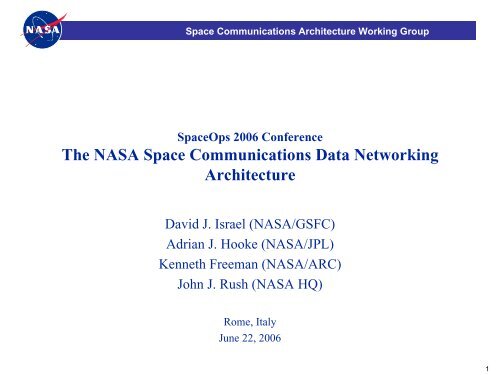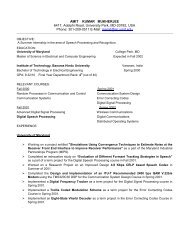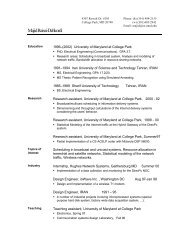The NASA Space Communications Architecture Working Group
The NASA Space Communications Architecture Working Group
The NASA Space Communications Architecture Working Group
You also want an ePaper? Increase the reach of your titles
YUMPU automatically turns print PDFs into web optimized ePapers that Google loves.
<strong>Space</strong> <strong>Communications</strong> <strong>Architecture</strong> <strong>Working</strong> Office Name<br />
Office Name<br />
<strong>Group</strong><br />
<strong>Space</strong>Ops 2006 Conference<br />
<strong>The</strong> <strong>NASA</strong> <strong>Space</strong> <strong>Communications</strong> Data Networking<br />
<strong>Architecture</strong><br />
David J. Israel (<strong>NASA</strong>/GSFC)<br />
Adrian J. Hooke (<strong>NASA</strong>/JPL)<br />
Kenneth Freeman (<strong>NASA</strong>/ARC)<br />
John J. Rush (<strong>NASA</strong> HQ)<br />
Rome, Italy<br />
June 22, 2006<br />
1
<strong>Space</strong> <strong>Communications</strong> <strong>Architecture</strong> <strong>Working</strong> Office Name<br />
Office Name<br />
<strong>Group</strong><br />
<strong>The</strong> <strong>NASA</strong> <strong>Space</strong> <strong>Communications</strong> <strong>Architecture</strong> <strong>Working</strong> <strong>Group</strong><br />
(SCAWG)<br />
• Chartered to develop a space communications and navigation<br />
architecture to support <strong>NASA</strong> Science and Exploration missions<br />
through the 2030 time frame.<br />
• Membership from across all <strong>NASA</strong><br />
• Initial architecture recommendation report was completed in May 2006<br />
2
<strong>Space</strong> <strong>Communications</strong> <strong>Architecture</strong> <strong>Working</strong> Office Name<br />
Office Name<br />
<strong>Group</strong><br />
Top Level Conceptual Communication <strong>Architecture</strong> ~2030<br />
Martian<br />
Local Network<br />
Lunar Local<br />
Network<br />
Martian<br />
Trunk<br />
Lunar<br />
Trunk<br />
L1/L2<br />
Individual<br />
<strong>Space</strong>craft<br />
Connections<br />
Earth<br />
Local Network<br />
3
Earth-based<br />
Antenna<br />
Element<br />
<strong>Space</strong> <strong>Communications</strong> <strong>Architecture</strong> <strong>Working</strong> Office Name<br />
Office Name<br />
<strong>Group</strong><br />
Overall <strong>Architecture</strong><br />
Network <strong>Architecture</strong><br />
Spectrum Framework<br />
Security <strong>Architecture</strong><br />
Navigation <strong>Architecture</strong><br />
Earth-based<br />
Relay<br />
Satellite<br />
Element<br />
Lunar<br />
Relay<br />
Satellite<br />
Element<br />
Mars<br />
Relay<br />
Satellite<br />
Element<br />
CROSSCUTTING ARCHITECTURE<br />
ELEMENT ARCHITECTURES<br />
4
<strong>Space</strong> <strong>Communications</strong> <strong>Architecture</strong> <strong>Working</strong> Office Name<br />
Office Name<br />
<strong>Group</strong><br />
Scope of the <strong>Space</strong> <strong>Communications</strong> Network<br />
Data Flow<br />
Information Flow<br />
End<br />
Users<br />
(Earth)<br />
Control<br />
Centers<br />
Earth Ground<br />
Stations<br />
Relays<br />
End<br />
Users<br />
(Remote)<br />
<strong>NASA</strong> SPACE COMMUNICATIONS NETWORK<br />
• End users interconnected logically via a series of physical layer “hops”<br />
• Information exchange between users flows logically (dashed lines) from<br />
source to destination independent of the underlying network structure.<br />
• <strong>The</strong> individual hops connect adjacent elements of the architecture and feature:<br />
– Terrestrial links connecting users to control centers, users to ground stations, or<br />
control centers to ground stations.<br />
– In-space links connecting ground stations to remote user vehicles, ground stations<br />
to relays, relays to relays, relays to remote user vehicles, remote vehicles to remote<br />
vehicles, or interconnecting end systems within remote vehicles.<br />
5
<strong>Space</strong> <strong>Communications</strong> <strong>Architecture</strong> <strong>Working</strong> Office Name<br />
Office Name<br />
<strong>Group</strong><br />
Driving Requirements on the Networking <strong>Architecture</strong><br />
• Provide multi-mission data communication services for:<br />
– Legacy missions<br />
– New Science missions<br />
– New Exploration missions<br />
• Support internetworked space and ground elements<br />
• Provide data communication service “on-ramps” for future government and,<br />
potentially, commercial service providers<br />
• Accommodate both scheduled and unscheduled communications<br />
• Accommodate both continuous and intermittent connectivity<br />
• Provide service over space data links characterized by:<br />
– Both large and small signal propagation latencies<br />
– Both uni-directionality and bi-directionality<br />
– Both low and high bit error rates<br />
• Support data flows that:<br />
– Originate at arbitrary user locations on Earth and in space<br />
– Terminate at arbitrary user locations or sets of user locations (i.e., multi-point<br />
delivery) on Earth and in space<br />
– Traverse N-hop transmission paths where N > 1<br />
6
<strong>Space</strong> <strong>Communications</strong> <strong>Architecture</strong> <strong>Working</strong> Office Name<br />
Office Name<br />
<strong>Group</strong><br />
Driving Requirements on the Networking <strong>Architecture</strong> (cont’d)<br />
• Support transmission of the following types of data:<br />
– Command<br />
– Telemetry<br />
– Files (including web pages)<br />
– Messages (e.g., electronic mail)<br />
– Voice<br />
– Video<br />
– Range safety<br />
• Provide the following qualities of data communication service (not<br />
necessarily in all combinations):<br />
– Isochrony<br />
– Reliability<br />
– Transmission order preservation<br />
– Timeliness<br />
– Priority<br />
• Provide data communication performance metrics and accountability<br />
7
<strong>Space</strong> <strong>Communications</strong> <strong>Architecture</strong> <strong>Working</strong> Office Name<br />
Office Name<br />
<strong>Group</strong><br />
Layered Service <strong>Architecture</strong><br />
End<br />
User<br />
End<br />
User<br />
User<br />
Application<br />
User<br />
Application<br />
Service Access<br />
Service Access<br />
Provides a well-defined<br />
service to a user<br />
Computer A<br />
Layer (n+1)<br />
Computer B<br />
Layer (n+1)<br />
Offers a well-defined<br />
service to the Layer<br />
above<br />
Draws upon a well-defined<br />
service from the Layer<br />
below<br />
Layer (n)<br />
Communicates with<br />
the remote end<br />
of the layer<br />
using well-defined<br />
rules (protocol)<br />
Layer (n)<br />
Layer (n-1)<br />
Layer (n-1)<br />
<strong>Space</strong> <strong>Communications</strong> Path<br />
8
End<br />
User<br />
<strong>Space</strong> <strong>Communications</strong> <strong>Architecture</strong> <strong>Working</strong> Office Name<br />
Office Name<br />
<strong>Group</strong><br />
Exposed Services<br />
End<br />
User<br />
User<br />
Application<br />
Service Access<br />
User<br />
Application<br />
Service Access<br />
Layer (n+1)<br />
Layer (n+1)<br />
Layer (n)<br />
“on-ramps” for<br />
accessing services<br />
Layer (n)<br />
Layer (n-1)<br />
Layer (n-1)<br />
<strong>Space</strong> <strong>Communications</strong> Path<br />
9
<strong>Space</strong> <strong>Communications</strong> <strong>Architecture</strong> <strong>Working</strong> Office Name<br />
Office Name<br />
<strong>Group</strong><br />
“On-Ramps” Enable Key Capabilities<br />
• Basic emergency commanding can be done by bypassing all but the<br />
most rudimentary communications services<br />
• Legacy systems, which do not necessarily conform to all the standard<br />
service layers, may be accommodated<br />
• Different organizations (e.g., future commercial providers) may “drop<br />
in” their services as a confederated contribution to the overall end-toend<br />
network.<br />
10
<strong>Space</strong> <strong>Communications</strong> <strong>Architecture</strong> <strong>Working</strong> Office Name<br />
Office Name<br />
<strong>Group</strong><br />
Mapping of Abstract Layers to Mission Facilities<br />
End<br />
User<br />
(Earth)<br />
User<br />
Workstation<br />
Flight Computer<br />
End<br />
User<br />
(Remote)<br />
User<br />
Application<br />
User<br />
Application<br />
Application<br />
Service<br />
Transport<br />
Service<br />
Network<br />
Service<br />
Network<br />
Service<br />
Application<br />
Service<br />
Transport<br />
Service<br />
Control<br />
Center<br />
Link<br />
Service<br />
Link<br />
Service<br />
Ground<br />
Station<br />
Physical<br />
Service<br />
Physical<br />
Service<br />
<strong>Space</strong><br />
Vehicle<br />
11
<strong>Space</strong> <strong>Communications</strong> <strong>Architecture</strong> <strong>Working</strong> Office Name<br />
Office Name<br />
<strong>Group</strong><br />
Layered Services in a <strong>Space</strong> Relay Data Flow<br />
End<br />
User<br />
(Earth)<br />
User<br />
End<br />
System<br />
Relay<br />
System<br />
User<br />
End<br />
System<br />
End<br />
User<br />
(Remote)<br />
User<br />
Application<br />
Relaying Application:<br />
Real Time or Store-and-Forward<br />
User<br />
Application<br />
Application<br />
Service<br />
Transport<br />
Service<br />
Application<br />
Service<br />
Transport<br />
Service<br />
Network<br />
Service<br />
Network<br />
Service<br />
Network<br />
Service<br />
Link<br />
Service<br />
Link<br />
Service<br />
Link<br />
Service<br />
Link<br />
Service<br />
Physical<br />
Service<br />
Physical<br />
Service<br />
“Bentpipe”<br />
Physical<br />
Service<br />
Physical<br />
Service<br />
12
<strong>Space</strong> <strong>Communications</strong> <strong>Architecture</strong> <strong>Working</strong> Office Name<br />
Office Name<br />
<strong>Group</strong><br />
Options Considered for Service Infrastructure Standardization<br />
• At the Physical Layer (Bit/Symbol stream services only).<br />
• Up to the Link Layer, with access to a standard Physical layer.<br />
• Up to the Network Layer, with access to standard Link and Physical<br />
layers.<br />
• Up to the Transport Layer, with access to standard Network, Link and<br />
Physical layers.<br />
• Up to the Application Layer, with access to standard Transport,<br />
Network, Link and Physical layers.<br />
13
<strong>Space</strong> <strong>Communications</strong> <strong>Architecture</strong> <strong>Working</strong> Office Name<br />
Office Name<br />
<strong>Group</strong><br />
Figures of Merit (FOM) Utilized in Trade Study<br />
• Operational Efficiency: <strong>The</strong> proportion of mission operations activity that<br />
must be performed by humans over the entire mission lifecycle, regardless of<br />
location.<br />
• Robustness: A compound FOM consisting of:<br />
– <strong>The</strong> ease with which additional elements can be added to a mission or mission set<br />
(scalability)<br />
– <strong>The</strong> ease with which new operational capabilities can be introduced into mission<br />
operations systems (evolvability)<br />
– <strong>The</strong> ease with which data paths through the network can be changed in response to<br />
changing mission requirements (adaptability)<br />
– <strong>The</strong> proportion of the operational time in which the network operates without error<br />
(reliability)<br />
– <strong>The</strong> ease with which errors can be remedied (maintainability)<br />
– <strong>The</strong> proportion of wall clock time in which the network operates (availability).<br />
• Infrastructure Capability: (Communication Infrastructure Development and<br />
Maintenance Efficiency): <strong>The</strong> ease with which mission functionality is<br />
developed and maintained over the entire mission lifecycle, at vehicle end user<br />
terminals (spacecraft, aircraft, etc.); at ground stations and relay points; and<br />
Earth end user terminals (control centers, science centers, test facilities).<br />
14
<strong>Space</strong> <strong>Communications</strong> <strong>Architecture</strong> <strong>Working</strong> Office Name<br />
Office Name<br />
<strong>Group</strong><br />
Figures of Merit (cont’d)<br />
• Ease of Transition: <strong>The</strong> ease with which the option can be<br />
implemented within <strong>NASA</strong>, including the acquisition of new<br />
equipment, development of new technology, and training of mission<br />
operators.<br />
• Interoperability: <strong>The</strong> ease with which users are able to complete all<br />
negotiations required to achieve successful and secure communication<br />
of mission information among both <strong>NASA</strong> and non-<strong>NASA</strong> assets and<br />
facilities.<br />
• Resource Utilization: Total value of user data delivered, given fixed<br />
resources. <strong>The</strong>se resources include link utilization, available memory,<br />
available power, visibility windows, and launch mass.<br />
15
<strong>Space</strong> <strong>Communications</strong> <strong>Architecture</strong> <strong>Working</strong> Office Name<br />
Office Name<br />
<strong>Group</strong><br />
Weighted FOM Scores<br />
60<br />
50<br />
40<br />
30<br />
20<br />
10<br />
0<br />
Physical Link Network Transport Applications<br />
<strong>Architecture</strong> Options<br />
16
<strong>Space</strong> <strong>Communications</strong> <strong>Architecture</strong> <strong>Working</strong> Office Name<br />
Office Name<br />
<strong>Group</strong><br />
Trade Study Conclusions<br />
• Standardization should reach at least to the Network layer, although<br />
the benefits of standardization continue to increase above this layer.<br />
<strong>The</strong> Network layer is the “thin waist” of interoperability.<br />
• In order to support Network layer standardization, standardization of<br />
the underlying Physical and Link layers is required when different<br />
organizations act as the termini for the individual data links in the endto-end<br />
path.<br />
• <strong>The</strong> choice for a Network layer standard is assumed to be the Internet<br />
Protocol, IP<br />
• However, the complete IP suite cannot be sustained across the entire<br />
Networking <strong>Architecture</strong>, an enhanced version of Network service –<br />
such as Disruption Tolerant Networking (DTN) – should be developed<br />
17
<strong>Space</strong> <strong>Communications</strong> <strong>Architecture</strong> <strong>Working</strong> Office Name<br />
Office Name<br />
<strong>Group</strong><br />
Next Steps<br />
• Detailed protocol selection trade-offs<br />
• Standard options at each layer based on existing and developing<br />
CCSDS and IETF standards with guidance for option selection by<br />
missions<br />
• Implementation of networking architecture across <strong>NASA</strong>’s <strong>Space</strong><br />
<strong>Communications</strong> <strong>Architecture</strong><br />
18
<strong>Space</strong> <strong>Communications</strong> <strong>Architecture</strong> <strong>Working</strong> Office Name<br />
Office Name<br />
<strong>Group</strong><br />
Acronym List<br />
CCSDS<br />
DTN<br />
FOM<br />
GSFC<br />
HQ<br />
IETF<br />
IP<br />
JPL<br />
<strong>NASA</strong><br />
SCAWG<br />
Consultative Committee for <strong>Space</strong> Data Standards<br />
Disruption Tolerant Networking<br />
Figure of Merit<br />
Goddard <strong>Space</strong> Flight Center<br />
Headquarters<br />
Internet Engineering Task Force<br />
Internet Protocol<br />
Jet Propulsion Laboratory<br />
National Aeronautics and <strong>Space</strong> Administration<br />
<strong>Space</strong> <strong>Communications</strong> <strong>Architecture</strong> <strong>Working</strong> <strong>Group</strong><br />
19






